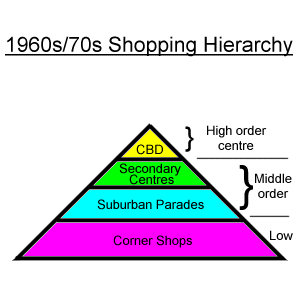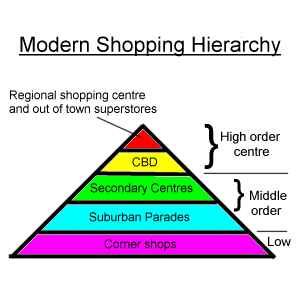![[internet geography]](../images/pagelayout/netgeologo.gif)
![]()
Physical Geography
Coasts
Earthquake
Ecosystems
Glaciation
Limestone
Plate Tectonics
Rivers
Volcanoes
Weather and climate
National Parks
Human Geography
Landuse
Migration
Urbanisation
Economic Geography

|
Shopping Hierarchy
|
|
Shops can be placed into a hierarchy based on the services they provide. At the bottom of the hierarchy are small shops selling low order, convenience goods (e.g. bread and milk). At the top are the shops selling high order goods (e.g. furniture and electrical goods). What was the British shopping hierarchy of the 1960's and 1970's?
The diagram above shows the shopping hierarchy for Britain in the 1960s/70s. At the bottom are corner shops. These sell low order goods. They are greater in number than any other shopping area. Above the corner shops are suburban parades and secondary centres. These sell middle order goods. This is usually a mixture of convenience and specialist goods. There are usually several of these areas within a large settlement. At the top is the CBD (central business district - town/city centre). There is usually only one CBD in a town or city. The CBD contains shops which sell comparison goods (shops containing goods which you will compare the prices of - due to their expense!), luxury and specialist shops. What is today's British shopping hierarchy?
Can you spot the difference between today's modern settlement hierarchy with the hierarchy from the 1960's/70's? The CBD is no longer at the top of the shopping hierarchy It has been superseded by regional shopping centres (e.g. Meadowhall, The Metro Centre and Merryhill). Due to increased mobility (the result of increased car ownership) people can travel further to shops, visit shops with a wider range and volume of stock and buy in bulk. There
have also been other, less obvious, changes in the settlement
hierarchy For example the number of corner shops have reduced.
This is the result of greater mobility, the limited and often
expensive range of goods available and due to more people being
paid monthly they buy in bulk from supermarkets. In some areas CBDs have declined due to competition with regional shopping centres. Dudley is an examples of this. The construction of the Merryhill Shopping Centre has caused huge problems in Dudley the local CBD. Many shops have closed or moved to the shopping centre.
|
![]()
GeoNet is not responsible for the content of any of these sites

